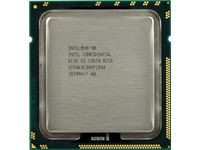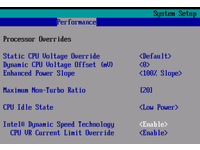UPDATE: Core i7: Blazing Fast, O/C Changes
UPDATED: Overclocking--Overspeed Protection, Explained
Overclocking Made Different
Overclocking is very different on the Core i7. Unlike the Core 2 or Pentium D processors, the Core i7 CPU can monitor the current it draws as well as its power consumption—if it exceeds a certain level, the processor automatically reduces its clock speed. Intel calls this feature "Overspeed Protection." The limits hard-wired into the core are 100 A and 130 watts. Only the Extreme Edition allows the user to change these values at will, effectively circumventing the protection mechanism altogether.
Chris Angelini: The rest of this page has been re-written to reflect our secondary overclocking efforts using a wider range of hardware and benchmarks to confirm the results.
Intel says that Overspeed Protection exists as a means of keeping notebooks, servers, etc. from encountering stability issues due to overzealous tweaking. However, the company acknowledges its contingent of overclocking enthusiasts, and provides a BIOS switch able to work around the feature. As discussed in our recent Editor’s Corner, this is called CPU VR Current Limit Override in the DX58SO’s BIOS.
If you’re running an i7 920 or 940, enabling this software-based workaround will let you smoke right past the 100A/130W limits, as we did in that first update.
After running a handful of benchmarks to confirm that our Core i7 920 was in fact operating at 3.8 GHz on ASUS’ Rampage II Extreme, we can comfortably say this issue has been addressed and, if anything, is a platform problem. There’s no way to guarantee that all X58-based motherboards will include a bypass to Overspeed Protection, but it’s a fair bet that if Intel—perhaps the most conservative motherboard vendor around—is willing to enable it, so too will the third-party board vendors.
If you have any other questions about Intel’s artificial overclocking ceiling, again, refer back to the Editor’s Corner story, where we demonstrate the effects of getting hit by Overspeed Protection and getting past it.
Get Tom's Hardware's best news and in-depth reviews, straight to your inbox.
Current page: UPDATED: Overclocking--Overspeed Protection, Explained
Prev Page X58 Chipset With ICH10 Next Page UPDATED: Overclocking Up To 3.80 GHz-
pullmyfoot AMD’s HyperTransport protocol can transmit up to 25.6 GB/s at 3.20 GHz.Reply
You mean Intel don't you? Other than that little mistake, good article
-
wh3resmycar hmm, question. once this nehalems come out. will we ever see a dieshrunk c2q again after the penryns? im expecting the price of this procs along with the mobo and ram to be too far off from my budget. orReply -
skywalker9952 One of the first side effects of Intel's domination of the CPU market is beginning to show. Since they don't have to compete with AMD in any market segment the i7 occupies, they have limited (significant) overclocking to only extreme models.Reply
RIP AMD.
May Abu Dhabi restore you to life soon so we don't have to suffer through more Intel ripoffs. -
sonar610 "The fastest Core i7, the 965 Extreme, is more than 2.6 times as fast as AMD’s current flagship CPU, the Phenom X4 9550 BE."Reply
This seems like an editing mistake maybe it should be 9950BE. -
cryogenic Core i7 is a great CPU, the article is not. I can't believe after all this time you still stack overclocked CPUs with unoverclocked ones. It's great to find out the overclocking potential of Nehalem but, at least include some overclocked Penryns in there too, to see how overclocked Nehalem stacks agains OTHER overclocked CPUs, because it's fairly evident that and overclocked new gen CPU will stack well with older non overclocked ones.Reply
-
joseph85 CryogenicCore i7 is a great CPU, the article is not. I can't believe after all this time you still stack overclocked CPUs with unoverclocked ones. It's great to find out the overclocking potential of Nehalem but, at least include some overclocked Penryns in there too, to see how overclocked Nehalem stacks agains OTHER overclocked CPUs, because it's fairly evident that and overclocked new gen CPU will stack well with older non overclocked ones.If it's evident then who cares?Reply -
fender22 skywalker9952One of the first side effects of Intel's domination of the CPU market is beginning to show. Since they don't have to compete with AMD in any market segment the i7 occupies, they have limited (significant) overclocking http://en.wikipedia.org/wiki/Overclocking to only extreme models.RIP AMD. May Abu Dhabi restore you to life soon so we don't have to suffer through more Intel ripoffs.Reply
My thoughts exactly... I wonder if there will be some sort of resistance to this sort of thing... It's like buying a car, you can do whatever you want to it (within the limits of the law) to make it as fast as you want. Sure, you may void your factory warranty, but it's your deal. You don't see car companies making it impossible for you to do what you want to their cars so you have to buy their expensive high end just to get your kicks... (not a perfect comparison, but it works)
I dunno, it's just pretty weak. And they are just taking advantage of the situation... -
cangelini sonar610"The fastest Core i7, the 965 Extreme, is more than 2.6 times as fast as AMD’s current flagship CPU, the Phenom X4 9550 BE." This seems like an editing mistake maybe it should be 9950BE.Reply
Fixed, thanks! -
onearmedscissorb Aside from the all too prevalent and potentially misleading typos, which someone needed to get a handle on as of months ago, I must say that the overall quality of this article is MUCH better than pretty much anything I can remember of the last few months. It's actually informative and thought out, rather than being a mess of assumptions that many people reading already know better than.Reply
Keep it up, and maybe I'll pay attention to this site like I used to.
But just for the record, I don't believe that it's particularly appropriate to use the overall average performance percentages as a basis for comparison between the "speed" of Core 2 vs. Core i7. Obviously, most people are going to be interested in the difference with games, where it's likely to be pretty minimal. But here and there, you have something like the 55% WinRAR difference pretty much skewing what otherwise would have been an accurate depiction of average expectations across the board.

